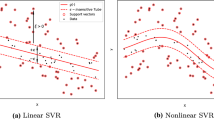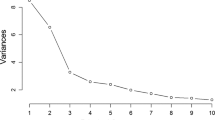Abstract
This paper introduces and extensively explores a forecasting procedure based on multivariate dynamic kernels to re-examine—under a non-linear, kernel methods framework—the experimental tests reported by Welch and Goyal (Rev Financ Stud 21(4):1455–1508, 2008) showing that several variables proposed in the finance literature are of no use as exogenous information to predict the equity premium under linear regressions. For this new approach to equity premium forecasting, kernel functions for time series are used with multiple kernel learning (MKL) in order to represent the relative importance of each of the variables. We find that, in general, the predictive capabilities of the MKL models do not improve consistently with the use of some or all of the variables, nor does the predictability by single kernels, as determined by different resampling procedures that we implement and compare. This fact tends to corroborate the instability already observed by Welch and Goyal for the predictive power of exogenous variables, now in a non-linear modelling framework.




Similar content being viewed by others
Notes
In financial series, the length of the different time series is variable since it is a function of the number of business days of each month, among other causes.
For a vector of positive scalars \(\varvec{z}=(z_1,z_2,\ldots ,z_n)^{\top }\), the softmin is defined as \(\log \sum e^{-z_i}\).
Publicly available from http://www.hec.unil.ch/agoyal/.
The dividends data is obtained from R. Shiller’s website and the S&P Corporation.
Part of this data is extracted from R. Shiller’s website and part is the result from an interpolation process by Welch and Goyal.
The training results are computed refitting the model using the best set of parameters.
References
Aiolli F, Donini M (2015) EasyMKL: a scalable multiple kernel learning algorithm. Neurocomputing 169:215–224
Ang A, Bekaert G (2007) Stock return predictability: is it there? Rev Financ Stud 20(3):651–707
Bach FR, Lanckriet GR, Jordan MI (2004) Multiple kernel learning, conic duality, and the SMO algorithm. In: Proceedings of the twenty-first international conference on machine learning. ACM, p 6
Bergmeir C, Hyndman R, Koo B (2015) A note on the validity of cross-validation for evaluating time series prediction. Department of Econometrics and Business Statistics, Working Paper, ISSN 1440-771X
Box GEP, Hunter JS, Hunter WG (2005) Statistics for experimenters: design, innovation, and discovery, 2nd edn. Wiley, New York ISBN: 978-0-471-71813-0
Campbell JY, Shiller RJ (1988) The dividend-price ratio and expectations of future dividends and discount factors. Rev Financ Stud 1:195–228
Campbell JY, Thompson SB (2008) Predicting excess stock returns out of sample: can anything beat the historical average? Rev Financ Stud 21(4):1509–1531
Chang C, Lin C (2001) Training \(\nu \)-support vector classifiers: theory and algorithms. Neural Comput 13(9):2119–2147
Cho Y, Saul L (2009) Kernel methods for deep learning. Adv Neural Inf Process Syst 22:342–350
Cochrane JH (1992) Explaining the variance of price-dividend ratios. Rev Financ Stud 5:243–280
Cochrane JH (2006) The dog that did not bark: a defense of return predictability. Rev Financ Stud 21:1533–1575
Cochrane JH (2011) Presidential address: discount rates. J Finance 56(4):1047–1108
Cuturi M, Vert J-P, Birkenes Ø, Matsui T (2007) A kernel for time series based on global alignments. In: IEEE international conference ICASSP 2007, pp II–413. IEEE
Cuturi M, Doucet A (2011) Autoregressive kernels for time series. Technical Report arXiv:1101.0673
Cuturi M (2011) Fast global alignment kernels. In: Proceedings of the 28th international conference on machine learning (ICML-11), pp 929–936
Fábregues L, Arratia A, Belanche LA (2017) Forecasting financial time series with multiple kernel learning. In: Advances in computational intelligence: 14th international work-conference on artificial neural networks, IWANN 2017, Cádiz
Fama EF, French KR (1988) Dividend yields and expected stock returns. J Financ Econ 22:3–25
Fletcher Hussain TZ, Shawe-Taylor J (2010) Currency forecasting using multiple kernel learning with financially motivated features. In NIPS 2010 workshop: new directions in multiple kernel learning
Geler Z, Kurbalija V, Radovanovi M, Ivanovi M (2014) Impact of the Sakoe-Chiba band on the DTW time series distance measure for kNN classification. In: Buchmann R, Kifor CV, Yu J (eds) Knowledge science, engineering and management. KSEM 2014 (LNCS, vol 8793). Springer
Hansen LP, Hodrick RJ (1980) Forward exchange rates as optimal predictors of future spot rates: an econometric analysis. J Polit Econ 88:829–853
Kale DC, Gong D, Che Z, Liu Y, Medioni G, Wetzel R, Ross P (2014) An examination of multivariate time series hashing with applications to health care. In: IEEE international conference ICDM 2014, pp 260–269
Kothari SP, Shanken J (1997) Book-to-market, dividend yield, and expected market returns: a time-series analysis. J Financ Econ 44(2):169–203
Lettau M, Ludvigson S (2001) Consumption, aggregate wealth, and expected stock returns. J Finance 56(3):815–849
Peña M, Arratia A, Belanche LA (2016) Multivariate dynamic kernels for financial time series forecasting. In: 25th International conference on artificial neural networks, Springer LNCS, vol 9887, pp 336–344
Sakoe H, Chiba S (1978) Dynamic programming algorithm optimization for spoken word recognition. IEEE Trans Acoust Speech Signal Process 26(1):43–49
Schölkopf B, Smola AJ, Williamson RC, Bartlett PL (2000) New support vector algorithms. Neural Comput 12(5):1207–1245
Shiller RJ (1981) Do stock prices move too much to be justified by subsequent changes in dividends? Am Econ Rev 71:421–436
Welch I, Goyal A (2008) A comprehensive look at the empirical performance of equity premium prediction. Rev Financ Stud 21(4):1455–1508
Author information
Authors and Affiliations
Corresponding author
Additional information
Publisher's Note
Springer Nature remains neutral with regard to jurisdictional claims in published maps and institutional affiliations.
This research is supported by Grant TIN2017-89244-R from MINECO (Ministerio de Economía, Industria y Competitividad) and the recognition 2017SGR-856 (MACDA) from AGAUR (Generalitat de Catalunya)
Rights and permissions
About this article
Cite this article
Arratia, A., Belanche, L.A. & Fábregues, L. An Evaluation of Equity Premium Prediction Using Multiple Kernel Learning with Financial Features. Neural Process Lett 52, 117–134 (2020). https://doi.org/10.1007/s11063-018-09971-7
Published:
Issue Date:
DOI: https://doi.org/10.1007/s11063-018-09971-7




